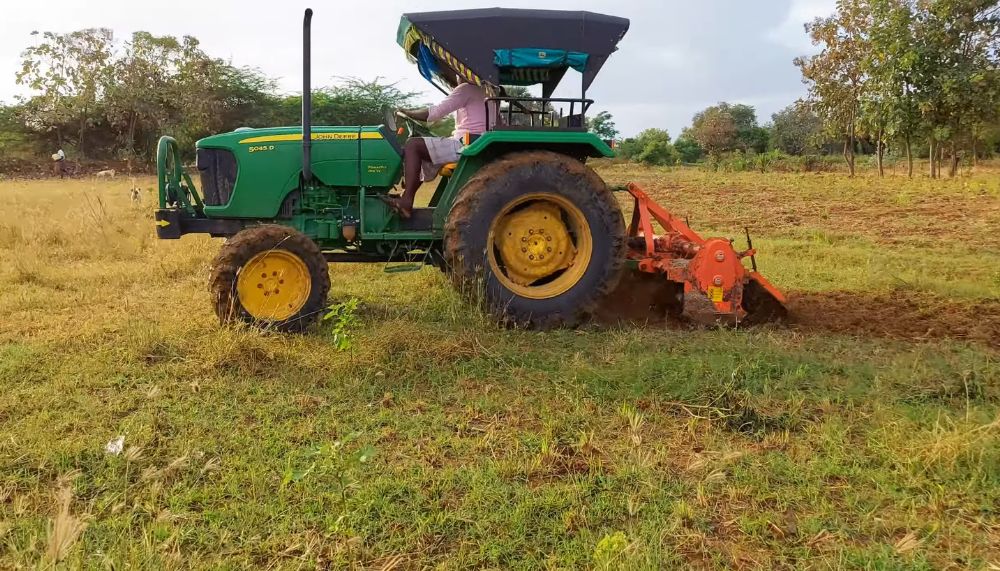Chat With Us
+91 99253 37969Top 9 Effective Uses of Rotavator That You Must Know

A rotavator or a rotary tiller is one of the most efficient tools used in modern-day agriculture. It uses rotating blades and advanced machinery to pulverize the soil. According to several case studies, rotavators are considered one of the best economical and effective tools for soil bed preparation.
But what are the gross advantages of using a rotary tiller above all these? Should you choose it for agricultural practices or not? We will answer all these questions in the following segment. So, let's find out.
What Are The Benefits Of Using A Rotavator or Rotary Tiller?
1. Soil Preparation and Tilling
A Rotavator can be used during both primary and secondary tillage activities. It is primarily used for cutting and pulverizing the soil for even seedbed preparation. The rotary tiller’s blades tilt the soil by breaking it into fine particles and removing clods.
The application is more effective than traditional tillage activities and results in finely leveled soil that promotes better seed germination. A Rotavator's sharp rotating blades can even penetrate hard and stony soils, therefore it is useful for different soil conditions.
2. Weed Control
Weed control is one of the major functions of a Rotavator. It helps in complete weed control by uprooting and burying the weeds during seedbed preparation or tillage activities.
The shard and rotating blades cut the parasitic plants into small pieces to reduce the chances of regrowth. This not only clears the field but also increases the availability of organic matter for germinating seeds.
3. Incorporation of Crop Residues
In India, relay cropping is one of the most used techniques for high productivity. It is effective but leaves a high amount of residues that can pose potential harm to the upcoming crops.
A Rotavator helps to incorporate these crop residues into the soil during primary tillage activities. It grinds the leftovers of past crops and mixes them well with the soil to increase the organic matter and nutrients of the soil.
4. Mixing Soil Amendments
A rotavator is an excellent equipment for soil amendments. It creates a uniform distribution of fertilizers, pesticides, and natural humus for consistent growth of plants throughout the field.
This balanced nutrient profile supports healthy root development and increases the effectiveness of fertilizers. It reduces wastage and optimizes input costs, which ultimately leads to higher crop productivity and quality.
5. Aeration Of Soil
Proper aeration of soil is important to ensure smooth seed germination and plant growth. A Rotavator not only cuts the soil but also breaks it into evenly fine pieces. These pieces help in creating air pockets in the soil.
The air pockets allow storing oxygen and essential air for the germinating seed and plant. Therefore, a rotary tiller creates a more hospitable environment for crops by streamlining the aeration process of soil.
6. Seedbed Preparation
Rotavators are typically used for seedbed preparation during secondary tillage activity. The crucial benefit of using a rotavator is it can be used for preparing suitable seedbeds for different essential crops.
It's compatibility and adjustable functions provide you the freedom to create seedbeds in various soil conditions with different crop types. Rotavators have been seen providing the maximum effective seed germination rates in comparison to other tools used for modern-day agriculture.
7. Pudding For Paddy Fields
Several crops such as cereals require pudding. Pudding involves waterlogged barriers that keep plants submerged in water. Rotavators are predominantly used to create pudding systems in fields. This maintains moisture in the field and is essential for some crops, for example, rice.
The moisture content reduces water filtration rates and improves plant growth. Pudding with a rotavator also helps in leveling the field and maintaining uniformity in terms of water distribution.
8. Prevention For Soil Erosion
Traditional ploughing methods can leave the soil vulnerable to erosion by wind and water, especially on sloped terrain. In contrast, rotavators help in reducing soil erosion by maintaining a layer of mulch or crop residue on the surface.
This cover acts as a protective barrier and reduces the impact of raindrops and wind on the soil. Moreover, the improved soil structure created by rotavating allows better water infiltration. It reduces runoff and prevents soil loss. By minimizing erosion, rotavators help in preserving topsoil, which is rich in organic matter and nutrients essential for healthy plant growth.
9. To Cover Multiple Tasks
Rotavators significantly reduce labor and time required for soil preparation by performing multiple tasks in a single pass, such as ploughing, harrowing, and leveling.
This multitasking capability reduces the need for several machines and labor, lowering overall operational costs. Rotavators are designed to cover large areas quickly, making them highly efficient for medium to large-scale farming operations.
Should You Invest In A Rotavator?
In summary, Rotavators serve a wide range of benefits for different agricultural purposes directly and passively. Rotary tillers can be an easy go-to choice above mouldboard ploughs and disc ploughs as they are economical and efficient.
Moreover, they serve a high rate of fuel efficiency and save a lot on both labor and time. So, when you are purchasing one for your agricultural needs?







